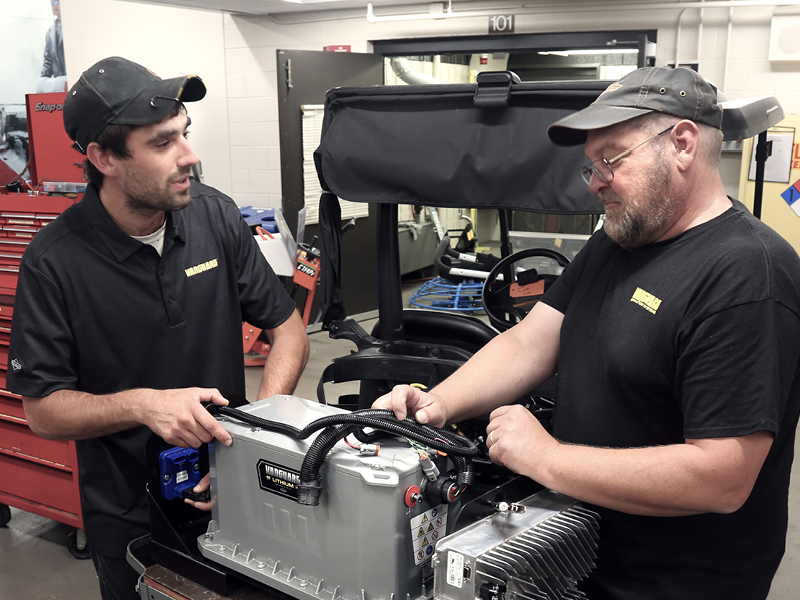The Battery Sizing Guide: How To Master Your Equipment's Duty Cycle
In the first installment of The Battery Sizing Guide, we established the foundational step for any electrification project: defining your equipment's fundamental power (kW) and energy (kWh) needs. This provides a clear picture of the maximum work your machine can do and the total energy it must store to complete its job.
This clear picture, however, raises the next logical question: How does the machine actually use that power and energy from moment to moment throughout its workday?
In this installment of The Battery Sizing Guide, we answer that question by building on your knowledge of power and energy to explore the pattern of how your equipment works over time — its duty cycle.
Simply put, a duty cycle is a profile of your equipment’s power usage over a period of time. It maps out the rhythm of your machine’s operation, from moments of intense work to periods of rest.

One of the most common misconceptions we encounter comes from confusing a workday with a duty cycle. An operator may be on the job for eight hours, but it’s unlikely the machine is running for eight continuous hours. A commercial lawn mower, for example, spends time on a trailer, being repositioned or sitting idle while the operator does other tasks. Assuming you need an eight-hour battery for an eight-hour shift is a classic mistake that leads to an oversized, overweight and overpriced system.
This is where electric power offers a distinct advantage. An internal combustion engine burns fuel even when it’s idling at a low RPM. In contrast, an electric machine uses virtually no energy when it’s not actively working. When an electric mower stops, the power draw drops to nearly zero. Understanding these idle periods is a crucial part of defining an accurate duty cycle and can significantly impact your final battery size.
Balancing Total Runtime With Peak Performance
It's helpful to analyze a duty cycle from two key perspectives. On a macro level, the workday cycle considers the big picture: Over a full shift, how much time is the machine actually in use versus parked, in transport or waiting? This view is critical for determining the total energy (kWh) the battery must store to get through the day. Then, on a micro level, the in-use cycle drills down into the granular, minute-by-minute power draw when the machine is running, revealing the peak power (kW) the battery must be able to deliver for the most demanding tasks.
Mapping Your Profile: Continuous, Intermittent and Pulsed Loads
The "in use" data will reveal a specific pattern of operation, which typically falls into one of three categories. Understanding your equipment's profile is key to selecting the right type of battery.
Continuous Load: The application demands a high, steady stream of power with very few breaks. A pressure washer is a classic example. These applications prioritize total energy capacity (kWh) to maximize runtime.
Intermittent Load: The work happens in clear on-and-off cycles. Think of a power tool that runs for a minute, stops, and then runs again.
Pulsed or "Peaky" Load: The application requires short bursts of extremely high power, followed by long periods of low power draw. An excavator digging and dumping dirt is a perfect example. These duty cycles require a battery that can handle high discharge rates for the peaks, which may influence the choice between a fixed or swappable battery system, as different battery constructions can be optimized for different demands.
Understanding whether your application has a continuous, intermittent or pulsed load profile is crucial, as it directly influences battery selection and overall system design. These decisions, however, cannot be based on assumptions. The only way to define your machine's true operational pattern is by measuring its performance during actual operation.
The Power of Prototyping
So, how do you map your duty cycle? While surveying end users about how they work is a fast and inexpensive way to gather information, it’s often flawed. An operator might honestly believe they use a machine for eight hours a day, but data often proves otherwise.
The most reliable method is the one we championed in our first article: prototyping and data acquisition.

By instrumenting a prototype and capturing its real-world usage data, you replace assumptions with certainty. Our Power Application Centers (PACs) and Battery Technology Partners specialize in this process. We work with you to analyze how your machine performs in different terrains, temperatures and operating conditions. This partnership brings two sets of experts to the table: your team, with its unmatched understanding of the application, and our team, with our deep knowledge of battery technology. This allows you to focus on overall vehicle design while leveraging our battery expertise to select and integrate the optimal power solution.
Next Up
Now you understand how to analyze your equipment's load profile and its unique pattern of operation. You have all the essential data. In the final article of The Battery Sizing Guide we’ll show you how to put it all together to translate your duty cycle into a specific kilowatt-hour (kWh) requirement and select the perfect battery for your application.




